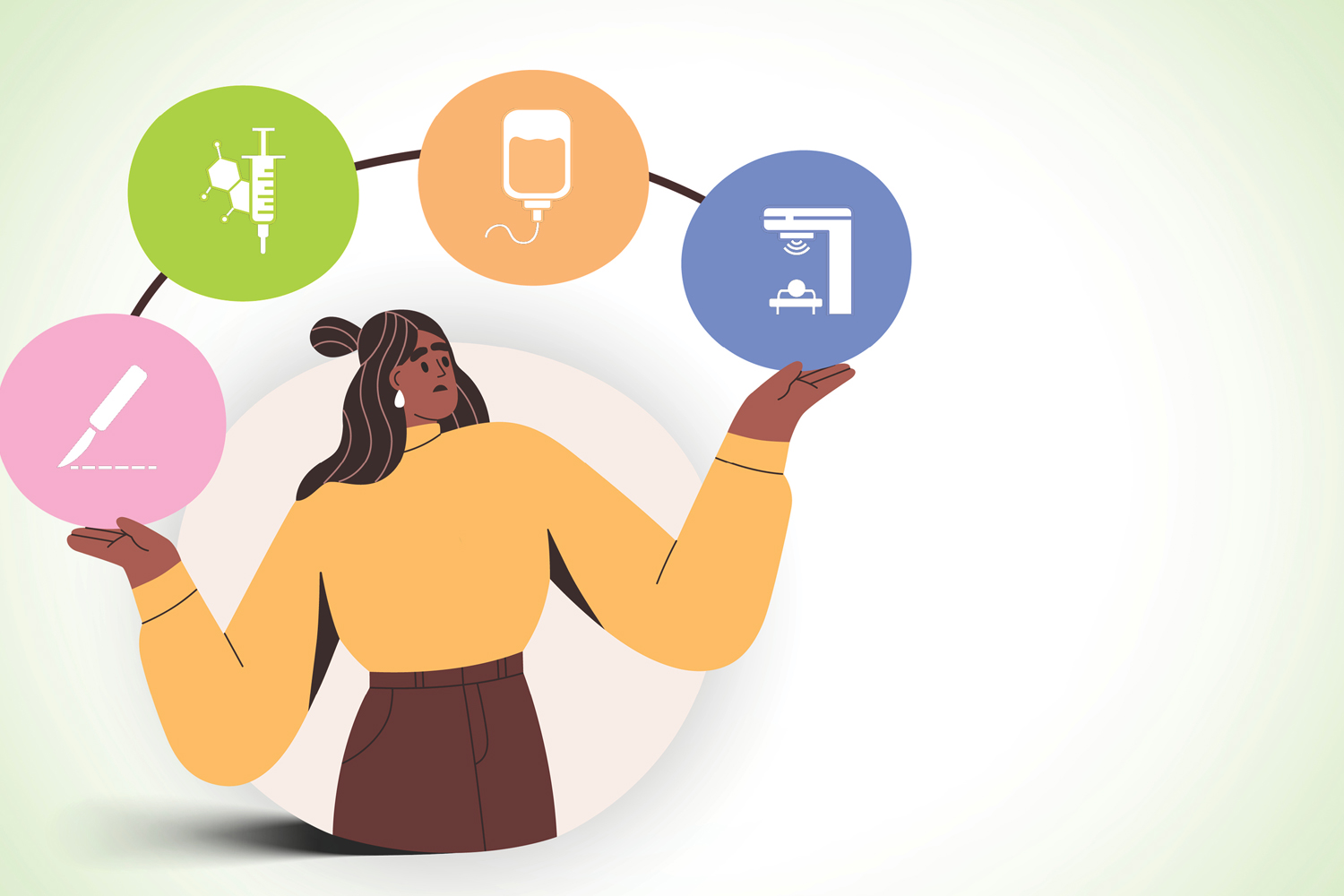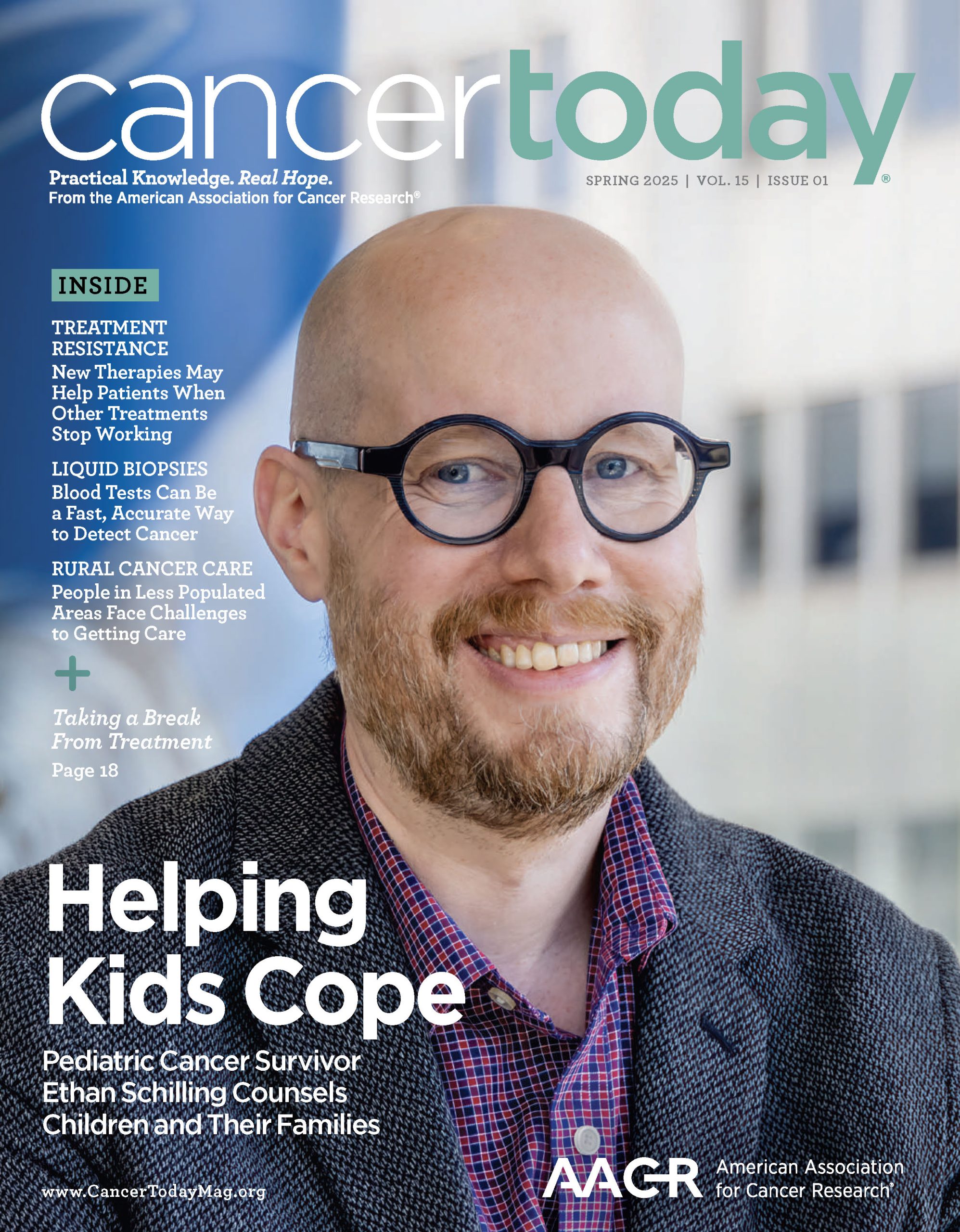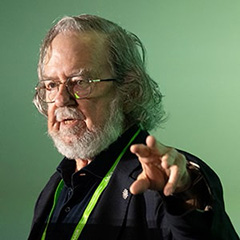IN SEPTEMBER 2021, Kate Hovde, a private consultant in education and social policy who lives in Philadelphia, went for a routine mammogram. An anomaly in her left breast prompted her doctors to recommend a sonogram, followed by an MRI and a biopsy. Afterward, she logged into her health portal and got a shock. The results, posted automatically before she’d talked with the radiologist, said she had cancer in that breast. Then 60 years old, Hovde was diagnosed with stage I estrogen receptor-positive, HER2-negative invasive breast cancer.
This was the rocky start to a somewhat chaotic path of care, Hovde says. Still reeling from her diagnosis, Hovde had to make a slew of important treatment decisions right away. She remembers feeling like she’d jumped straight into the deep end of the pool. “When you’re first diagnosed, you just feel overwhelmed, period,” she says. “I did not feel like I had sufficient information to make those decisions.”
Hovde, who received all her treatment at Abramson Cancer Center at Penn Medicine in Philadelphia, describes her first meeting with a breast surgeon that October as emotionally difficult. The surgeon relayed a lot of information, including two choices—lumpectomy plus radiation or a mastectomy—and urged Hovde to make the decision and her next appointment as soon as possible due to the surgeon’s packed schedule. After giving herself a few days to review her options, she decided she would schedule a lumpectomy, but that she would have a mastectomy if genetic testing came back positive for inherited mutations in one of the BRCA genes that significantly increase the risk of breast and ovarian cancer. Thankfully, the test showed she did not have those mutations.
After the lumpectomy that November, Hovde had to decide whether to undergo chemotherapy. A sample of tumor tissue was sent to a lab and analyzed using the Oncotype DX Breast Recurrence Score, which predicts how likely the cancer is to come back after surgery and whether chemotherapy in addition to hormone therapy might reduce the risk. Hovde was in the high-risk group for recurrence, but just barely. A score between 26 and 100 indicates that chemotherapy followed by hormone therapy would be likely to substantially reduce the risk of recurrence. Chemotherapy and hormone therapy are strongly recommended if a score is at the higher end of this range. Hovde’s result was 27.
Clinical trial data showed that most women in the intermediate range (11-25) did not benefit from receiving chemotherapy in addition to hormone therapy. This meant Hovde’s choice to have chemo was not cut-and-dried. “I was like, ‘Oh no, I have another decision here.’ I thought I would be done,” she says. Hovde wanted to do everything necessary to reduce the risk that her cancer would return, but she was nervous about side effects and didn’t want to have chemotherapy if it wasn’t needed.
She sought a second opinion from an oncologist at Redeemer Health in Meadowbrook, Pennsylvania, which is affiliated with MD Anderson Cancer Center at Cooper in Camden, New Jersey. The doctor talked her through her options and noted they could modify or scale back the intensity of chemotherapy if the side effects were too painful. “[The second oncologist] basically said, ‘It’s not as binary as it may feel.’ That was helpful,” Hovde recalls. She completed four rounds of chemotherapy ending in March 2022, followed by five rounds of partial breast radiation. Besides a few days of debilitating fatigue, she tolerated the treatment well.
After chemotherapy, Hovde started to take hormone therapy, which reduces the risk of breast cancer recurring after surgery. But first, she had to decide what kind of hormone therapy she would take. Tamoxifen is typically used if a woman is premenopausal. But aromatase inhibitors are more effective at reducing breast cancer recurrence in postmenopausal women. At the time, Hovde hadn’t experienced a period in nine months, three months shy of the clinical definition for being in menopause. Hovde and her oncologist assumed she was in menopause, but to be sure, they decided to run hormone blood tests, and results suggested she was indeed in menopause. That outcome pointed her toward an aromatase inhibitor, and she started taking Arimidex (anastrozole), which she still takes today.
By playing an active role in her care and asking a lot of questions, Hovde felt she was able to get the information she needed to make well-informed choices that felt exactly right for her as an individual and reduced her risk of recurrence. “With my background [in research], I tend to be more able to find the information [I need]. But you find all kinds of things, and a lot of it is not helpful,” she says. “I was super fortunate in having some people to call to help talk me through those decisions.”
A Multitude of Options
On one hand, patients with breast cancer are living longer and have many different treatment options. On the other hand, physicians increasingly realize the negative impact of treatment and side effects and understand that some patients can achieve the same outcomes using less intense therapies. For example, the Oncotype DX test can reportedly identify an estimated 85% of women with early-stage hormone receptor-positive, HER2-negative breast cancer who would not benefit from chemotherapy after surgery, allowing these women to avoid unnecessary treatment and side effects.
More recently, studies also suggest that skipping radiation after surgery can be an option for some older women with early-stage breast cancer. Current guidelines say that most women under 65 should receive radiation after a lumpectomy to catch any stray cancer cells. Most women 65 or older with small, nonaggressive, localized, estrogen receptor-positive tumors and negative margins after their surgery (meaning no cancer cells remain in the tissue surrounding the removed tumor) can safely forgo radiation and start hormone-suppressing medication. New data suggest that this approach could be safely expanded to women as young as 55 who want to forgo radiation, which can cause side effects and often makes people feel exhausted.
Many patients choose to not get breast reconstruction after a mastectomy.
A shift in social values has empowered more breast cancer patients to “go flat” after a mastectomy instead of having breast reconstruction, a surgery with risks that can prolong recovery time.
In a survey conducted by the UCLA Jonsson Comprehensive Cancer Center in Los Angeles, out of more than 900 women who decided to forgo breast reconstruction after a mastectomy, more than 1 in 5 experienced “flat denial.” These women reported that either their surgeon wasn’t supportive of them going flat or never offered the option. In some cases, the surgeon went so far as to intentionally leave a flap of skin in case the patient changed her mind. Almost two-thirds of respondents felt they received enough information to make the right surgical choice. Unsurprisingly, women who felt they had the most information about surgical options were the ones most satisfied with their outcome.
No one can predict with certainty whether skipping a treatment will lead to a negative outcome. This uncertainty can cause stress as patients make life-altering decisions without necessarily understanding medical language and terms. This is further complicated when a person is seeing multiple specialists with busy schedules. Hovde recalls feeling, at times, like a widget on an assembly line—her physicians met with her separately but didn’t necessarily consult with one another about her case. “Even with a quote, unquote, ‘coordinated’ care team at one of the best hospital systems in the country, it didn’t feel like everybody was totally on the same page all the time,” she says.
Breast cancer standards of care rely on data from groups of people, sometimes very large groups. But an individual’s treatment decisions, while taking these standards into account, also need to prioritize that patient’s personal preferences. These include their fear of disease recurrence and their tolerance for treatment side effects. It’s up to physicians to make sure patients understand both the benefits and risks of a treatment approach, says Enrique Soto, a geriatric oncologist and the associate director for global oncology at the University of Colorado Cancer Center in Aurora. “You cannot make a decision based on odds ratios and progression-free survival alone. You need the rest,” Soto says, noting the importance of working with patients to discuss their preferences and life goals. For breast cancer, there is an array of treatments available, and often it’s not clear whether one treatment has a therapeutic advantage over another. In choosing between a lumpectomy with radiation and a mastectomy, for example, the recurrence rate in general is not radically different, so patient values become the top priority.
On the other hand, when it comes to the decision to undergo chemotherapy, the stakes can be higher and harsh side effects are a concern. That choice can feel very difficult if the answer isn’t obvious from a medical standpoint, says Mary Politi, a health psychologist and director of the Center for Collaborative Care Decisions at Washington University School of Medicine in St. Louis. “It’s not like a surgery decision, where it’s usually one or two times that people have primary surgery,” she explains. “With chemotherapy, it occurs over the course of many months.” Meanwhile, the person still feels unwell, and there is a societal perception of chemotherapy that can be very challenging for some patients.
Factors like a patient’s finances and age can also change the trajectory of treatment, Soto says. “As we age, we measure time differently. When you were a kid, the time between your birthdays, or between Christmases, seemed eternal. But as we age, time flies by,” says Soto. Many of his older patients would rather forgo intensive treatments to retain their independence, cognitive function and living situation. An additional three months of survival or a few percentage points of risk reduction conferred by a given treatment might feel like huge gains for one patient, while for another, those improvements might mean very little in the face of tradeoffs such as harsh side effects or financial strain. Hovde feels that had she been 10 or 15 years older, she might have decided to skip chemotherapy. “I think it would have weighed differently,” she says.
Understanding patient values takes time and a good patient-physician relationship, Soto says. “It cannot be done in a single visit,” he explains, saying that too often, patients get a diagnosis and start treatment all in one fell swoop. “That’s not how these types of decisions should be made.”
Shared Decision-making
“The work that I do is really not making one recommendation; it’s helping people weigh the pros and cons of the different options available,” says Politi. In her practice, she asks patients up front if there is anything they are unwilling to experience as a result of treatment. A tennis player or pianist might be unwilling to have stiffness or pain in their hands, which can happen as a result of some breast cancer treatments. Some women choose more invasive surgery, such as a double mastectomy, because their fear of recurrence or a second cancer outweighs their desire to preserve breast tissue.
The first step is understanding the benefits and risks of any given treatment to make informed decisions. Politi and other researchers have developed decision aids that use plain, accessible language to elaborate on trade‑offs among treatment options. For example, the Breast Reconstruction Education and Support Tool (BREASTChoice) is an interactive aid that takes information about a patient’s disease and personal preferences and provides a risk assessment to help them decide whether to have breast reconstruction after a mastectomy. The tool presents pros and cons tailored to the patient, as well as information on risks of complications based on that person’s risk factors. Several other decision-making resources are also in the works at Washington University.
Another tool, developed at University of Virginia School of Medicine in Charlottesville, is designed to combat what its creators call the “Angelina effect.” The actor Angelina Jolie went public with her double mastectomy in 2013 due to a positive BRCA1 test indicating she was at significant risk of developing breast cancer. Since then, many women have decided to remove both breasts whether or not it’s warranted by their condition. Surgery to remove both breasts is much more intensive than a single mastectomy. The decision aid is intended to help women be more aware of the increased risks of bleeding and infection after a double mastectomy.
Online tools help people with breast cancer understand their treatment options in plain language.
In addition to the Breast Reconstruction Education and Support Tool (BREASTChoice) from Washington University in St. Louis, other breast cancer decision aids are available.
BRECONDA (Breast Reconstruction Decision Aid): This survey-style tool from the Breast Cancer Network Australia helps women decide whether to have breast reconstruction after a mastectomy.
Neoadjuvant Patient Decision Aid: This tool helps women with early-stage breast cancer decide whether to undergo neoadjuvant chemotherapy and hormone therapy. It’s available online as an interactive tool or as a booklet.
Healthwise Decision Points: The patient education nonprofit Healthwise has developed easy-to‑read decision support tools for many health conditions, including breast cancer. These include whether to have chemotherapy, gene tests, a lumpectomy or a mastectomy, and more. Ask your doctor or search online for “Healthwise Decision Points for breast cancer” to learn more.
The Ottawa Hospital Research Institute (OHRI) decision aids: OHRI has a searchable online inventory of decision aids for many conditions, including several breast cancer treatment guides.
Option Grids: Mary Politi, a health psychologist and director of the Center for Collaborative Care Decisions at Washington University School of Medicine in St. Louis, helped test an option grid developed by the company EBSCO Information Services to assist people with early-stage breast cancer in deciding between lumpectomy and mastectomy. Option grids compare treatment or screening options side by side so patients can see simple answers to common questions for each choice.
Politi encourages patients to ask for hard numbers when talking to their doctors about risks of side effects or recurrence. For example, using labels like “high,” “medium” or “low” without attaching a number can confuse patients. “[Patients] might think ‘high’ could be a 90% chance [of a given risk]. But really what we mean is just ‘higher than average,’ which could be 10% to 20%,” she explains.
Sometimes patients have preconceived, and often incorrect, notions about treatment. “It’s really hard to predict how you might feel about something occurring,” Politi says. People are often scared of chemotherapy, for example, because they have heard how painful and disruptive it can be. But when they go through it, they adapt better than they thought possible. Patients should feel empowered to seek out success stories and advice from other patients who have been through the same treatment, Politi says, so they can better imagine what it could be like.
When Hovde was deciding whether or not to do chemotherapy, she sought a second opinion from an oncologist and spoke with a friend, Jean Sachs, the CEO of Living Beyond Breast Cancer, a national nonprofit that connects breast cancer patients with information and support. When Hovde expressed concerns about nausea, her doctor and Sachs educated her about the many ways oncologists use drugs to better manage nausea. Thankfully, when she ultimately decided to have chemo, Hovde found that she needn’t have worried. “The anti-nausea medication they prescribed really worked well,” she says. “It was not as difficult as I’d thought it would be.
“No matter what the circumstances are, you need to be your own advocate, and you need people who can be your advocates,” Hovde adds.
Cancer Today magazine is free to cancer patients, survivors and caregivers who live in the U.S. Subscribe here to receive four issues per year.





